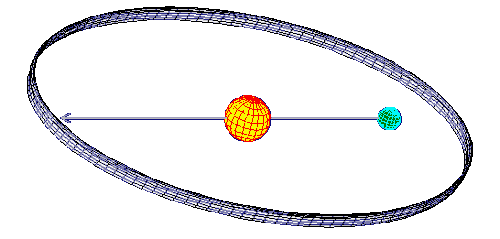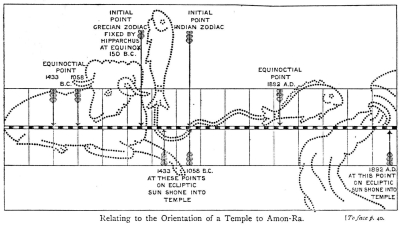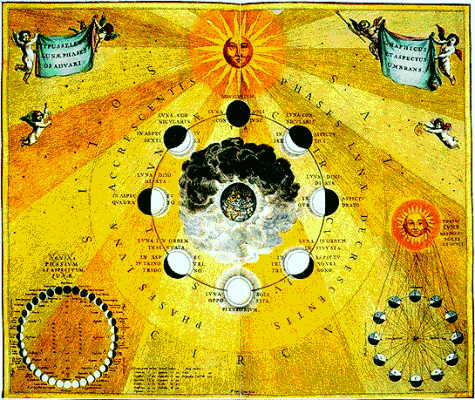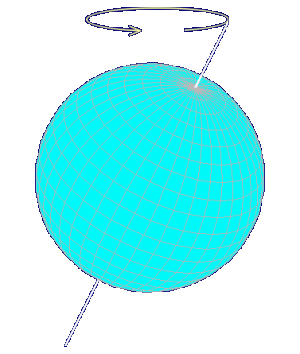|
Accompanying this polar symptom of the phenomenon, is the equatorial symptom, the �Precession of the Equinoxes�, reputedly first noted by Hipparchus (ca.190 BCE-125 BCE). The equinoxes are determined by the apparent passage of the Sun over the equator (corresponding with the moment in the Earth�s orbit when its axis is a tangent to the ellipse of the orbit) and this happens when the Earth-Sun system is at the same point in its cycle. The Sun therefore appears to be at the same position relative to the starry background each year. However, this shifts very gradually, by 50.26" a year, or roughly 1� every seventy years. Since the Sun and Full Moon appear to be about half a degree across their diameter, this shift is just perceptible within a life-time (��=30'=1800"). Hipparchus used his own observations and those of the previous 150 years to calculate the length of the tropical or solar year at 365.242 days (modern calculations give a mean length 365.242199; these are the figures given by the Encyclopaedia Britannica, others vary, and because the Earth�s speed varies, different figures arise for different reference points).

The point taken for measurement of the precession is usually the Vernal Equinox, which in our calendar takes place in March, and which is called the First Point of Aries, since the Equinox occurred when the Sun was in Aries when the terms were defined. This point is not arbitrary, representing one of two points where the ecliptic, the Sun�s apparent path or the plane of the Earth�s path round the Sun, crosses the Earth�s equator. The First Point of Aries marks the apparent passage of the Sun northwards over the equator and its counterpart, the First Point of Libra, marks its passage southwards. What is arbitrary is that this point is taken astronomically as 0 in terms of Right Ascension. The First Point of Aries is not, however, fixed: in the 2000 years leading up to the start of the Christian era, the apparent position of the Sun at the moment of the Vernal Equinox was in the constellation of Aries; it lay on the boundary between Aries and Pisces at the beginning of the Christian era, and has since then been shifting through Pisces and is approaching Aquarius (see Great Year).
Yeats himself gives quite a full treatment of the phenomenon of precession in the context of the �Great Year�, and uses the �slippage� of the Vernal Equinox backward through the constellations as the great chronocrator of the gyres� cycles (AV B 252-5; AV A 149-58). As Yeats identifies, the astronomical measurement of the time taken for a complete circle of the equinox�s progress against the stars and the changing of pole-stars is just under 26,000 years (25,786).
 The historical equinoctial point, with particular reference to the Temple of Amon-Ra; from E. M. Plunket, Ancient Calendars and Constellations, one of the books that Yeats consulted for A Vision.
The historical equinoctial point, with particular reference to the Temple of Amon-Ra; from E. M. Plunket, Ancient Calendars and Constellations, one of the books that Yeats consulted for A Vision.
To the astronomer, for whom the constellations and Zodiac are conveniences and purely geocentric illusions, this cycle is merely one of many, and, though it must be taken into account, it has no particular significance. To the astrologer, for whom the constellations, particularly those of the Zodiac, have meaning and influence, the phenomenon takes on other dimensions. One of these is that the passage of the Sun backwards through the twelve signs of the Zodiac, is a kind of year, and since each sign measures a month of the Sun's annual motion, the Sun�s precessional passage through one sign is a kind of month too, albeit some 2,150 years long. Since each sign is supposed to colour the way in which the Sun operates during the year, it follows that the Sun�s precessional passage through a sign will also be coloured by that sign. See the Astrological Great Year.
A further consequence for astrology is that there are now two Zodiacs in use, that based on the stars and that based on Earth�s seasons. The first, called the sidereal Zodiac (Latin: sidera, stars), is used in India for example, and corresponds largely with the constellations, though the divisions are regularised to 30� each; the second Zodiac is called tropical (Greek: tropoi, the turning-points of the Sun), the most widely used one in the West, and the signs of the Zodiac are defined by the position of the Sun at the equinoxes and solstices, which are the starts of the four cardinal signs: Aries, Cancer, Libra and Capricorn. The difference between these two Zodiacs is the effect of the precession (though the exact boundaries and date of coincidence are disputed), so that tropical Aries now starts at the same point as sidereal Pisces, and at midsummer, when the Sun is entering tropical Cancer, it is at the beginning of the constellation of Gemini. See the Astrological Zodiac.
 The Phases of the Moon and Eclipses, Andreas Cellarius, Atlas Coelestis (Amsterdam, 1660).
The Phases of the Moon and Eclipses, Andreas Cellarius, Atlas Coelestis (Amsterdam, 1660).The Moon measures two separate kinds of month in its orbit around the Earth. The independent sidereal month marks the return of the Moon to the same point in the sky reckoned by its position against the background of the stars (or, confusingly perhaps, with respect to the equinoctial points of the tropical system). The synodic month marks the return of the Moon to the same phase in the lunation cycle, usually New Moon to New Moon (Greek: synodos, meeting, conjunction). The apparent motion of the Moon taken on its own against the stars is relatively simple; in contrast the phases trace the relationship between moving bodies, the Moon and Sun, as seen from a Earth, so that when the same phase or relative position recurs their �absolute� sidereal positions are completely different, and the cycle is greater than a circle.

The Moon appears to move about 13� per day, though the distance varies from less than 12� to more than 15�, so that, if a reference point is taken with respect to the stars, the Moon returns to the same point in a mean time of 27.32 days. Based on this sidereal cycle, divisions of the circle into 27 or 28 have been used in various forms of astrology in China, India and Arabia. These are the lunar equivalent of the signs of the Zodiac and are generally known in European tradition through the Arabian system of the man�zil al-qumar, the resting-places of the Moon, usually translated via Latin as �Mansions� or �Stations�. (For more details, see the Mansions of the Moon.)
The Sun appears to move about 1� per day, in the same direction as the Moon, and in the opposite direction to its movement across the sky during the day. If one takes the star which is hidden by the New Moon as a reference point, when the Moon reaches the same star after 27.32 days, the Sun has moved some 27 degrees further on. After slightly more than two days the Moon makes up the difference, so that the synodic cycle is an average of 29.53059 days long (Hipparchus reached a figure of 29.53058). Most astrological uses of this cycle tend, therefore, to take the period as 29 or 30 days, usually 29. Examples include, for instance, Thomas Goode�s popular booklet The Gipsy Fortune Teller, which gives �Judgements for the 29 Days of the Moon� by W. Parker, Professor of Astrology, and Albert Raphael, writing in 1901, used 29 days as well in his �Prognostication from the Moon�s Age�. More symbolically, Eliphas L�vi�s The Magical Ritual of the Sanctum Regnum Interpreted by the Tarot Trumps (translated by William Wynn Westcott) gives 29 �days of the Moon� corresponding to the twenty-two Tarot Trumps and the seven planets of the ancients.
 |
Athanasius Kircher, Ars Magna Lucis et Umbrae (Rome: Scheus, 1646):
�The Selenic Shadowdial or the Process of the Lunation�.
The spirals show the length of the Moon�s appearance in the sky, with its rising and setting. The scheme gives the Moon twenty-eight phases and the engraver, Pierre Miotte, has reversed the appearance of the waxing and waning moons for the northern hemisphere. |
Although it has no direct relevance here, the Moon�s rotation period is exactly the same as its sidereal cycle, and it is because of this that one side of its surface is always hidden from Earth. In fact, only 41% is visible during any one lunar cycle, but �wobbles�, called librations, mean that 59% of the surface is visible over time.
Although there are twenty-nine or thirty (solar) days of the Moon, there is no fixed number for the phases of the Moon. There is a continuous change and cycle, and the most general division of that cycle is into eight: new, crescent, half, gibbous, full, waning gibbous, waning half, decrescent. Andreas Cellarius, however, in his Atlas Coelestis of 1660, gives 36 separate phases (see above). Obviously a natural division between the phases is the Moon�s appearance on subsequent days, though it appears for different lengths of time and at different times of day or night, so that 24 hours is not always the most natural interval.
A more logical reference point, perhaps, is the lunar equivalent of noon, its �southing� or culmination, even though the Moon is not always visible because of the Sun�s brightness. Because of its movement, the Moon souths 53 minutes later each day on average, so that �noon� to �noon� is on average 24.83 hours, which divided into the length of the synodic month (708.7 hours), gives 28.5, which is not so far from Yeats�s number.
The reason for choosing the Moon�s southing rather than moonrise or moonset, is that like sunrise and sunset these vary with the Moon�s position in the Zodiac, although, over the course of the month, they average the same length of �lunar day�. But averages are not real except in equatorial latitudes. In more extreme latitudes the difference depends on the Moon�s longitude, its apparent position in the Zodiac, in exactly the same way that the Sun�s path varies with the time of the year (and even with respect to the Sun, there are further complications produced by the Earth�s tilt and elliptical orbit, see Analemma.com, so that the earliest sunrise is not on the longest day etc., explained on Analemma�s page about "Other Phenomena"). The constellation of Gemini is always above the horizon for some 17 hours in Dublin (53�20'N), so that when the Sun�s position is aligned with Gemini, during June, the day lasts for 17 hours (and Gemini itself is invisible); the constellation of Sagittarius, in contrast, is only ever above the horizon in Dublin for some 7 hours, so that when the Sun is aligned with Sagittarius, in December, the day lasts for 7 hours. The same is true of the Moon, but its cycle is that of the sidereal month rather than the year. The new Moon is, of course, exactly the same as the Sun, but the full Moon is its complementary opposite. The full Moon of midwinter (December in northern latitudes), when the Moon is opposite to the Sun, will therefore be above the horizon for as long as the Sun at midsummer; and the full Moon of midsummer will be above the horizon for as long as the Sun at midwinter. The points of relative equality, therefore, are the full Moons in March and September, the months of the equinoxes, when the Sun and Moon are in the constellations of Pisces and Virgo. |
 |
The Moon�s position around the Zodiac, as the Moon�s �seasons�: Ver, Spring, from Aries to Gemini (A to B); Aestas, Summer, from Cancer to Virgo (B to C); Autumnus, Autumn or Fall, from Libra to Sagittarius (C to D); Hyems, Winter, from Capricorn to Pisces (D to A). The diagram includes the inevitable �mistake� of making the phases coincide with the Zodiac, though it counts thirty days for the cycle.
From Athanasius Kircher�s Ars Magna Lucis et Umbrae (1646). | |
The Full Moon in March, however, rises more slowly than the Full Moon in September, for those in the northern hemisphere. This is linked to the length of time which it takes various points of the ecliptic, and therefore also the constellations or signs of the Zodiac, to rise. Although they are all thirty degrees long, the signs of the Zodiac (either tropical or sidereal) rise over the horizon at different speeds, with the range of difference becoming progressively more extreme as one moves away from the equator, and more extreme at the �equinoctial� points than the �solstitial�. Taking the tropical signs used by western astrology, in the northern hemisphere the signs of Pisces and Aries rise in considerably less time than Virgo and Libra (in the sidereal Zodiac these are shifted to Aquarius and Pisces, Leo and Virgo). In Dublin, for instance, Aries rises in less than 50 minutes, while Libra rises in some 2 hours and 55 minutes. The so-called signs of �long ascension� in the tropical Zodiac are Cancer, Leo, Virgo, Libra, Scorpio and Sagittarius, while those of �short ascension� are Capricorn, Aquarius, Pisces, Aries, Taurus and Gemini. In the southern hemisphere, the situation is reversed. As a consequence of this phenomenon, the Full Moon in March, which will be in the tropical sign of Virgo, if it comes before the equinox, or Libra, if it comes after, and will rise slowly over the eastern horizon.
|










